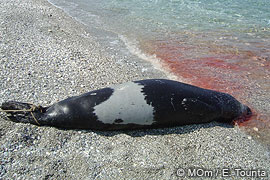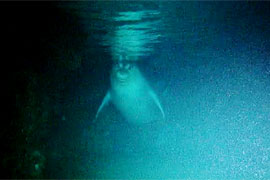Editorial, The Monachus Guardian, June 2010
 It is hard to imagine anyone not being moved by the tragic tale of ‘Markos’ – the young Mediterranean monk seal who was brought into intensive care, struggling for life, but horribly mutilated by the bullet that shattered his jaw and nasal cavity.
It is hard to imagine anyone not being moved by the tragic tale of ‘Markos’ – the young Mediterranean monk seal who was brought into intensive care, struggling for life, but horribly mutilated by the bullet that shattered his jaw and nasal cavity.
Possibly it was a blessing in disguise that, despite the valiant attempts to save him, he ultimately succumbed to his injuries, for it seemed doubtful that he would ever swim, dive, or grace the Aegean again.
The killing of monk seals in Greece, according to national NGO MOm, is reaching “epidemic proportions”.
The organisation has recorded 15 deaths since January, 5 of which yielded conclusive evidence of deliberate killing. Another killing by gunfire was reported in Turkey on the Bodrum peninsula on 21 April. With other killings just as likely to go undetected along remote coastlines, the final death toll is anybody’s guess.
Full Story
 Simon Nadim, Managing Director of the Pure Tech Diving Facility in Batroun, Lebanon, has contacted TMG to report two separate sightings of a Mediterranean monk seal, on the 15.08.2010 and 04.09.2010 respectively.
Simon Nadim, Managing Director of the Pure Tech Diving Facility in Batroun, Lebanon, has contacted TMG to report two separate sightings of a Mediterranean monk seal, on the 15.08.2010 and 04.09.2010 respectively.
 Venerdì 18 giugno lo staff del diving center “Massub” ha avvistato e fotografato, nella zona B dell’Area Marina Protetta (AMP), un esemplare di foca monaca di poco meno di 2 metri di lunghezza. Questa piacevole ed inaspettata notizia avviene proprio nell’anno internazionale della biodiversità; questa visita dimostra come le AMP siano dei veri e propri “santuari naturali” capaci di tutelare la biodiversità attraendo nuovamente specie scomparse. Ormai undici anni di gestione nell’AMP Portofino fanno sì che alcune specie di pesci (come Epinephelus marginatus), che erano pressoché scomparse, siano ora presenti, e in taglie considerevoli; proprio in questo contesto si inserisce la visita della foca monaca che, essendo ghiotta di grossi pesci non reperibili altrove, crediamo sia stata spinta a visitare la nostra AMP.
Venerdì 18 giugno lo staff del diving center “Massub” ha avvistato e fotografato, nella zona B dell’Area Marina Protetta (AMP), un esemplare di foca monaca di poco meno di 2 metri di lunghezza. Questa piacevole ed inaspettata notizia avviene proprio nell’anno internazionale della biodiversità; questa visita dimostra come le AMP siano dei veri e propri “santuari naturali” capaci di tutelare la biodiversità attraendo nuovamente specie scomparse. Ormai undici anni di gestione nell’AMP Portofino fanno sì che alcune specie di pesci (come Epinephelus marginatus), che erano pressoché scomparse, siano ora presenti, e in taglie considerevoli; proprio in questo contesto si inserisce la visita della foca monaca che, essendo ghiotta di grossi pesci non reperibili altrove, crediamo sia stata spinta a visitare la nostra AMP. It is hard to imagine anyone not being moved by the tragic tale of ‘Markos’ – the young Mediterranean monk seal who was brought into intensive care, struggling for life, but horribly mutilated by the bullet that shattered his jaw and nasal cavity.
It is hard to imagine anyone not being moved by the tragic tale of ‘Markos’ – the young Mediterranean monk seal who was brought into intensive care, struggling for life, but horribly mutilated by the bullet that shattered his jaw and nasal cavity.